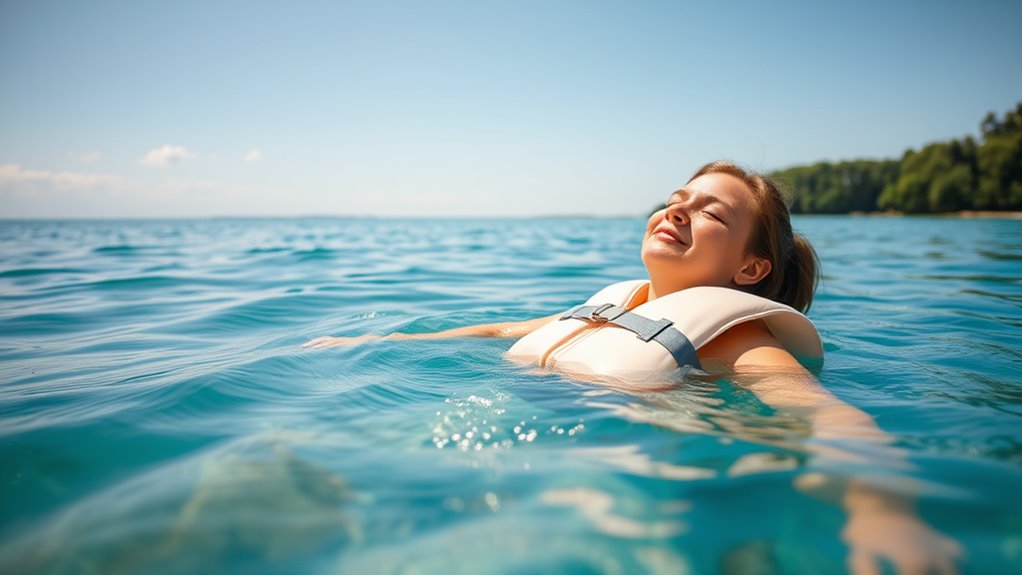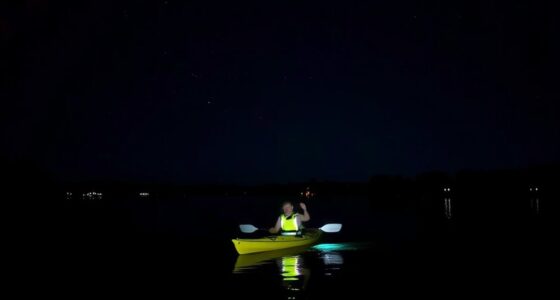To manage motion sickness while floating, focus on calming visualization techniques like imagining yourself on a peaceful lake or in a clear sky. Keep your body relaxed with slow, deep breaths and stay hydrated with light, easily digestible snacks beforehand. Communicate any sensitivities to staff and adjust the environment if needed. Using these strategies can help ease discomfort and create a more relaxing experience—if you want more tips, keep exploring ways to stay comfortable.
Key Takeaways
- Practice visualization of calm, peaceful environments before and during your float to reduce nausea.
- Consume light, easily digestible foods and stay hydrated prior to your session.
- Use slow, deep breathing techniques to calm your nervous system and alleviate dizziness.
- Communicate with staff about your sensitivities to adjust the environment for comfort.
- Engage in gentle stretching or a brief walk beforehand to promote circulation and ease motion sensitivity.

Floating can be a serene experience, but for some, it triggers motion sickness that disrupts the calm. If you find yourself feeling queasy or dizzy during your float sessions, don’t worry—there are effective ways to manage these symptoms. One approach involves using visualization techniques. As you lie in the float tank, focus your mind on calming images—imagine yourself floating smoothly on a tranquil lake or drifting effortlessly through a clear sky. Visualizing a peaceful environment can help your brain reframe the sensations and reduce nausea. Practice this mental imagery regularly before your float to strengthen its calming effect, making it easier to stay relaxed when discomfort arises.
Alongside visualization, dietary adjustments can make a significant difference. Eating heavy or greasy foods right before your session may worsen motion sickness. Instead, opt for light, easily digestible snacks—like crackers, bananas, or toast—about an hour before you float. Hydration also plays a role; drink plenty of water beforehand to stay well-hydrated, but avoid excessive caffeine or alcohol, which can dehydrate you or increase jitteriness. Some people find that ginger supplements or ginger tea help settle their stomach, so consider incorporating these into your pre-float routine if nausea tends to be a problem. These dietary tweaks help stabilize your stomach and minimize the likelihood of feeling queasy during your session.
Another tip is to prepare your body with gentle physical activity beforehand. Light stretching or a quick walk can promote circulation and reduce anxiety, which sometimes exacerbates motion sickness. When you arrive at the float center, communicate your sensitivities to the staff so they can adjust the environment if needed, such as controlling the temperature or lighting. During your float, maintaining a steady, slow breathing pattern can also help; inhale deeply through your nose, hold briefly, then exhale slowly through your mouth. This breathing technique calms your nervous system and can diminish feelings of nausea. Additionally, being aware of potential air quality factors and ensuring proper ventilation can contribute to a more comfortable experience.
Frequently Asked Questions
Can Certain Medications Prevent Motion Sickness During Floating?
Certain medications can help prevent motion sickness during floating, but their effectiveness varies from person to person. You should consult a healthcare professional to discuss options like antihistamines or anti-nausea drugs, which may serve as preventative measures. Keep in mind, medication works best when combined with other strategies like staying hydrated, maintaining a stable head position, and avoiding heavy meals before floating. Always follow medical advice for safe use.
Does Diet Impact Susceptibility to Motion Sickness While Floating?
Your diet does impact how susceptible you are to motion sickness while floating. Nutritional adjustments, like eating light and avoiding greasy foods before your session, can help reduce nausea. Staying well-hydrated with water or electrolyte drinks also supports your body’s balance. These hydration strategies and mindful eating habits can make your floating experience much more comfortable and lessen the chances of feeling sick during your session.
Are There Specific Breathing Techniques to Reduce Nausea?
Yes, practicing breathing exercises and meditation techniques can help reduce nausea while floating. Try slow, deep breaths, inhaling through your nose and exhaling through your mouth to calm your nervous system. Focus on steady, rhythmic breathing to ease discomfort. Incorporating mindfulness meditation techniques can also help you stay relaxed and centered, decreasing the likelihood of motion sickness. Consistent practice makes these techniques more effective over time.
How Long Does It Typically Take to Recover From Motion Sickness?
Like a storm passing in the sky, recovery from motion sickness varies, but generally, it takes about 15 to 30 minutes for symptom alleviation. Your body needs time to reset and settle after the sensation of disorientation. Staying still, hydrating, and practicing deep breathing speed up recovery duration. If symptoms persist longer, it’s wise to rest and seek fresh air, ensuring you regain your balance swiftly and comfortably.
Is Motion Sickness More Common in First-Time Floaters?
Yes, motion sickness is more common in first-time floaters because your body hasn’t yet adapted to the sensory changes. You might feel floaters’ anxiety, which can heighten discomfort. As you continue floating, your sensory adaptation improves, reducing the likelihood of motion sickness. To ease this process, focus on calming techniques and deep breaths, helping your body adjust more quickly and making your experience more enjoyable.
Conclusion
By applying these tips, you’ll find floating becomes a smooth sail rather than a turbulent storm. Remember, your body’s balance is like a delicate dance—sometimes it takes a gentle nudge to find harmony. Embrace patience and stay calm; with practice, you’ll steer through motion sickness just like a skilled captain steering calm seas. Soon, floating will feel as natural as breathing, turning what once felt like a storm into a tranquil voyage.









